Associated Ribbon Bar Commands

•Command: Edit 
Edit the simulation parameters referring to the active simulation. •Command: Duplicate
Combination of Copy, Paste & Edit.
•Command: Run 
Run a simulation using the default fixed-grid simulator. •Command: Adaptive Grid Simulator
Run a simulation using the adaptive-grid simulator.
•Command: Pause 
Pause or continue the currently running active simulation. •Command: Break
Break the currently running active simulation.
•Command: Compare 
Copy the active simulation and the currently selected active experiment to the Tab-Window: Compare Curves to show a direct comparison of both.
•Command: Circles 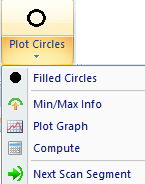
The active current curve is plotted in the form of open circles. •Command: Filled Circles
The active current curve is plotted in the form of filled circles. •Command: Min/Max Info
Show the E-I-couple referring to the minimum/maximum found in a mouse drawn rectangle on the screen display. •Command: Plot Graph
Plot data obtained by means of Min/Max Info (or by selecting a a particular current point by double clicking on the active current curve) as function of scan rate, electrode size, species concentration etc. The graph is displayed in the Tab-Window: Plot Graph. •Command: Compute
Opens a dialog box that enables the user to compute data (for instance, the differences of peak potentials) from the Min/Max Info displayed on the screen. •Command: Next Scan Segment
Activate the next scan segment If the active simulation consists of more than one. |
•Clipboard Command: Copy 
Copy the active simulation and put the copy on the clipboard. •Clipboard Command: Cut
Cut the active simulation and put it on the clipboard. •Clipboard Command: Paste
Paste clipboard content into the Tab-Window: Simulations.
•Command: RAM-Disk 
Open a dialog box showing the actual content of the RAM-Disk. The RAM-Disk stores data in use-file format and can be used, for instance, to export CVs simulated in the Tab-Window: Simulations to the Tab-Window: Experiments. In this way experimental curves can be mimicked by simulated ones, for instance, in order to investigate how systematic errors such as noise are passed to individual parameter values when using these files in a fitting project.
•RAM-Disk Command: Export 
Export the active simulation to the RAM-Disk •RAM-Disk Command: Add all Simulation to RAM-Disk
Export all simulations shown in the Tab-Window: Simulations in use-format and stores the use-files in the RAM-Disk.
•File Command: Export 
Export the active simulation as use- or txt-file. •File Command: Export all Simulations
Export all simulations shown in the Tab-Window: Simulations as use- or txt-files. |
•Command: Next 
The next current curve is activated. •Command: Previous
The previous current curve is activated.
•Command: Delete Active Simulation 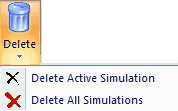
Delete the active simulation. •Command: Delete All Simulations
Delete all simulations shown in the Tab-Window: Simulations.
•Command: Zoom 
Zoom the screen display of the rectangle drawn by holding down the left mouse button. The zoom command can be repeatedly applied. •Command: Unzoom
Undo the last zoom command. •Command: Refresh
Remove Min/Max-Info and redraws the screen display.
•Option: Plot 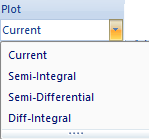 oCurrent
Plots current vs. potential oSemi-Integral
Plots the semi-integrated current curve as function of the potential oSemi-Differential
Plots the semi-differentiated current curve as function of the potential oDiff-Integral
Plots the Diff-Integral of the current curve as function of the potential. The order of the Diff-Integral can be specified in a dialog box that shows up after selecting this option. (see: "The Fractional Calculus: Theory and Applications of Differentiation and Integration to Arbitrary Order" by Keith B. Oldham and Jerome Spanier (Dover Books on Mathematics).
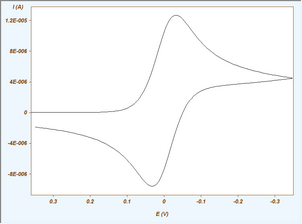 Current |
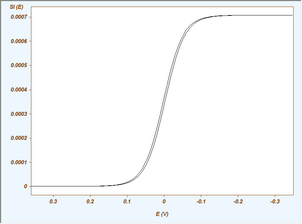 Semi-Integrated Current |
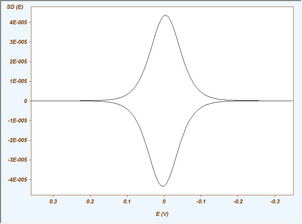 Semi - Differentiated Current |
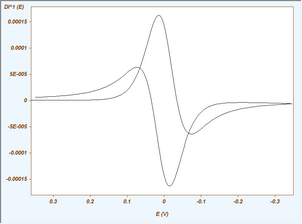 Diff-Integral of Order 1
(equal to simple First Order Differentiation) |
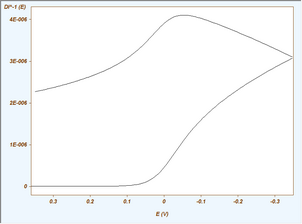 Diff-Integral of Order -1
(equal to simple Integration) |
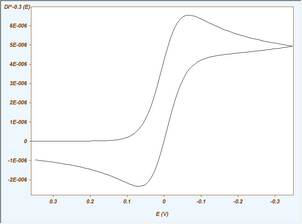 Diff-Integral of Order -0.3
|
 Note that the above Plot options are only available if use the same scan rate in each scan segment has been selected Note that the above Plot options are only available if use the same scan rate in each scan segment has been selected
|
Summary: Play Video
Topics
•Defining simple charge-transfer mechanism
•Specify the simulation parameters
•Running a simulation
•Adding/Removing Reaction Equations for heterogeneous charge-transfer reactions
•Adding/Removing Scan Segments
•Adding Reaction Equations for homogeneous chemical reactions
•Copy a Simulation and Paste it into another Simulation Document
•Copy & Paste Simulation Documents
•Running a CV-Simulation using different scan rates in the forward and backward scan
•Simulating the current response for a Thin-Layer Cell experiment and for a Rotating Disc electrode
•Options Diffusion:Semi-Infinite-1D, Finite, Semi-Infinite-2D, Hydrodynamic
•Clipboard commands: Copy, Paste
•Display commands: Zoom, Unzoom, Refresh Screen, Next, Previous
•Commands: Edit, Duplicate, Run, Circles, Filled Circles, Next Scan Segment, Min/Max Info
•Compute data from Min/Max Info, Plot Graph from Min/Max Info
During the download of the video clip the scrolling of this page may be disabled!























